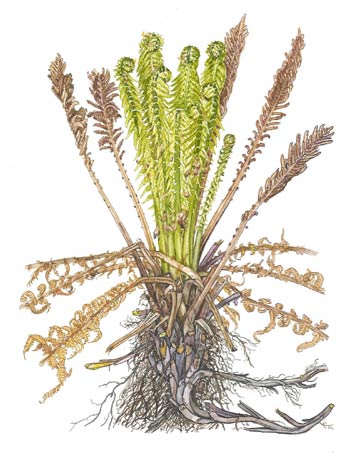|
Hardy Fern Home M. struthiopteris resources
All Ferns � Woodsiaceae �� Matteuccia
�Other Genera
|
| Matteuccia struthiopteris | ||
Ostrich fern | ||
|
Etymology
Struthiopteris, Latin, from struthio, ostrich, + pteris, Greek, from pteron, a wing, referring to the shape of the pinnae, but the word pteris was used by the ancient Greeks for ferns in general.
Description
Rhizome: erect, forming a vase-like plant, becoming short trunks with age, armoured with black, old stipe bases, appearing braided.
Frond: 150 cm high by 30 cm wide, sterile: deciduous, late-appearing; fertile: appearing midsummer, persisting into winter, infrequently produced, dimorphic, the fertile frond to 40 cm x 6 cm, blade/stipe ratio: 5:1. Stipe: green, with an expanded base (trophopod), white hairs on sterile frond, also orange-brown scales, vascular bundles: 2, s-shaped, back-to-back, at an acute angle. Blade: sterile: 1-pinnate-pinnatifid, elliptic, widest one-quarter below apex, abruptly reduced towards the tip, sterile: herbaceous, fertile beady, green young, maturing to dark brown, absent or deciduously hairy below. Pinnae: 20 to 60 pair, proximal pinnae (several pairs) greatly reduced, sessile; pinnules oblong, blunt, 20--40 pairs per pinna; costae shallowly grooved above, grooves not continuous from rachis to costae; margins entire; veins free. Sori: round, covered by revolute margins, indusium: vestigial, sporangia: green, maturity: the following spring. Culture
Habitat: moist soil in deciduous and mixed forest, wooded river bottoms, and swamps.
Distribution: circumboreal.
Hardy to -40�C, USDA Zone 2.
Distinctive Characteristics
handsome, tall, vase-shaped crown of fronds, in dense stands
Synonyms
Osmunda struthiopteris L. Matteuccia struthiopteris (L.) Todaro var. pensylvanica (Willd.) C.V.Morton Matteuccia pensylvanica (Willd.) Raymond Matteuccia struthiopteris (L.) Todaro var. pubescens (Terry) Clute Onoclea struthiopteris (L.) Hoffm. var. pensylvanica (Willd.) B.Boivin Pteretis nodulosa (Michx.) Nieuwl. Pteretis nodulosa (Michx.) Nieuwl. f. pubescens (Terry) Fernald Pteretis pensylvanica (Willd.) Fernald Pteretis pensylvanica (Willd.) Fernald f. pubescens (Terry) Fernald Pteretis struthiopteris (L.) Nieuwl. Struthiopteris pensylvanica Willd. |
|
|
Notes
Calciphile/calciphobe Curiously, some accounts have it requiring acid soil, others stipulate a calcareous one.
var. pensylvanica differs in having a dark, central stripe in the scales, the sort of difference that marks some pteridologists as splitters supreme. It also might be noted that both text and illustration in Scandinavian Ferns, �llgaard and Tind, describe stem scales with a darker central stripe. This raises the ugly possibility that the original diagnosis failed to mention the dark central stripe. Certainly room for a Ph.D. here.
Calciphile/calciphobe Curiously, some accounts have it requiring acid soil, others stipulate a calcareous one.
var. pensylvanica differs in having a dark, central stripe in the scales, the sort of difference that marks some pteridologists as splitters supreme. It also might be noted that both text and illustration in Scandinavian Ferns, �llgaard and Tind, describe stem scales with a darker central stripe. This raises the ugly possibility that the original diagnosis failed to mention the dark central stripe. Certainly room for a Ph.D. here.

Matteuccia struthiopteris. Two s-shaped vascular bundles, back to back, throughout the length of the stipe. �Drawing from Ferns of Northeastern United States, Farida A. Wiley, 1936. |

Matteuccia struthiopteris. Emerging fronds. �Illustration from Scandinavian Ferns by Benjamin �llgaard and Kirsten Tind, Rhodos, 1993. |

Matteuccia struthiopteris. Feertile and sterile fronds. �Illustration from Scandinavian Ferns by Benjamin �llgaard and Kirsten Tind, Rhodos, 1993. |
